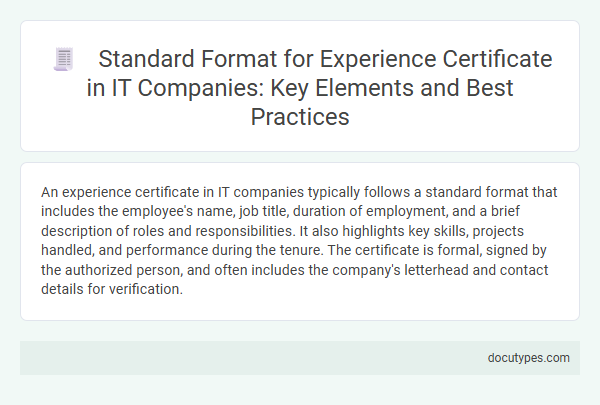An experience certificate in IT companies typically follows a standard format that includes the employee's name, job title, duration of employment, and a brief description of roles and responsibilities. It also highlights key skills, projects handled, and performance during the tenure. The certificate is formal, signed by the authorized person, and often includes the company's letterhead and contact details for verification.
Introduction to Experience Certificates in IT Companies
Experience certificates serve as official proof of your professional tenure and skills in IT companies. These documents detail your role, duration of employment, and key contributions within the organization.
IT companies follow a standard format to ensure clarity and authenticity in experience certificates. A well-structured certificate helps establish credibility and supports career growth in the competitive tech industry.
Importance of a Standardized Experience Certificate
The standard format for an experience certificate in IT companies typically includes the employee's name, designation, duration of employment, key responsibilities, and a statement of performance. A well-structured experience certificate serves as an official proof of professional experience and skills gained during your tenure. Such standardized documents hold significant importance in validating your work history to future employers and enhancing career opportunities.
Essential Components of an IT Experience Certificate
| Component | Description |
|---|---|
| Company Letterhead | Official header containing the IT company's name, logo, and contact details, ensuring authenticity. |
| Employee Details | Full name, designation, and employee ID to clearly identify the individual. |
| Duration of Employment | Exact dates of joining and leaving, highlighting the total period worked in the company. |
| Job Role and Responsibilities | Detailed description of your position, key duties, and technologies or projects handled. |
| Performance Statement | Brief assessment of the employee's performance, skills, and professional conduct. |
| Certification Statement | Formal declaration confirming the employee's tenure and experience at the company. |
| Authorized Signatory | Name, designation, signature, and date from the HR or authorized person to validate the certificate. |
Standard Format Overview for IT Experience Certificates
Experience certificates in IT companies follow a standardized format to ensure clarity and professionalism. The format typically highlights the employee's role, tenure, and key contributions within the organization.
- Header Section - Includes the company's name, logo, and contact details to authenticate the certificate.
- Employee Details - Specifies the employee's full name, designation, and period of employment for precise identification.
- Job Role and Responsibilities - Outlines the specific roles and technical skills demonstrated during the tenure to validate experience.
Personal and Employment Details Section
The standard format for the Personal and Employment Details section in an experience certificate for IT companies includes the employee's full name, designation, and employee ID. It also specifies the duration of employment with exact joining and relieving dates.
This section typically outlines key job responsibilities and the department in which the employee worked. It may highlight significant projects or technologies handled to emphasize expertise. Accurate personal and employment information ensures the certificate's authenticity and aids future employers in verifying the candidate's professional background.
Description of Roles and Responsibilities
The standard format for an experience certificate in IT companies highlights the candidate's roles and responsibilities clearly and concisely. This section provides a detailed overview of the employee's key duties and achievements during their tenure.
- Role Description - Specifies the job title and primary functions performed by the employee.
- Key Responsibilities - Outlines the main tasks and projects managed by the candidate in their role.
- Technical Skills and Tools Used - Enumerates the technologies, programming languages, and software platforms the employee worked with.
Duration and Tenure Specification
In IT companies, the standard format for an experience certificate emphasizes clear specification of the duration and tenure of employment. This ensures transparency and authenticity in verifying an employee's work history.
- Exact start and end dates - The certificate must clearly state the employee's joining and relieving dates to define the employment period.
- Total duration of employment - It should summarize the entire length of service, typically expressed in years, months, and days.
- Designation and tenure details - The certificate includes the roles held along with the specific tenure under each designation during the employment period.
Precise mention of duration and tenure is critical for validating professional experience in IT industry certificates.
Skills and Technologies Highlighted
The standard format for an experience certificate in IT companies typically includes the employee's name, designation, tenure, and a detailed summary of roles and responsibilities. Skills and technologies highlighted often cover programming languages like Java, Python, or JavaScript, frameworks such as React or Angular, and tools including Git or Docker. Your certificate may also emphasize problem-solving abilities, project management skills, and familiarity with Agile methodologies to validate your professional expertise.
Best Practices for Drafting IT Experience Certificates
An experience certificate in IT companies typically follows a standardized format that includes the employee's name, designation, duration of employment, and a brief description of roles and responsibilities. This format ensures clarity and professionalism, making it easier for future employers to assess the candidate's experience.
Best practices for drafting IT experience certificates involve using precise technical language relevant to the employee's job functions and highlighting key projects or technologies worked on. Including the issuing authority's signature, company seal, and date of issuance further validates the certificate's authenticity.
What Is the Standard Format for an Experience Certificate in IT Companies? Infographic

